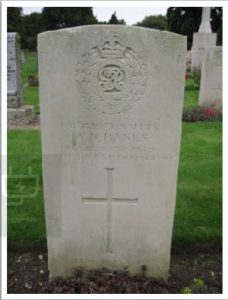Royal Engineers (Inland Waterways & Docks)

William Nicholas Hanks was born in 1878 at Painswick, Gloucestershire. His parents were Albert who was a general labourer and his wife Mary, who at the time of the 1911 Census lived at Edge Road, Painswick.
It is believed that the couple had six children (with approximate year of birth): James (1876); William Nicholas (1878); Walter (1882); Sidney Edgar (1883); Elizabeth (1885) and Leonora (1887) although according to the 1911 Census one of the children had died by this date.
On 27 February 1906 William (aged 27) married Annie Maud Arthur (age 22) at All Saints Church in Gloucester and the couple went on to have a daughter (born 1907) and possibly one other child.
At the time of his marriage William was working as a miner and living at 8 Vauxhall Road, Gloucester. He is shown in the 1909 Electoral Register as a resident of Cecil Road, Gloucester. He, his wife and daughter were present in a house other than their own on the night of the 1911 Census.
At that time, he was employed as a painter with the Gloucester Wagon & Carriage Works. A surviving Army Pension Record reveals that William had a military career prior to the Great War.
On 18 December 1893 he enlisted in the Gloucestershire Regiment (and was allocated the number 4247), for a period of twelve years. He stated his age to be 18 years and six months but he was probably just over 16 and had been working as a labourer.
He served in the UK until 16 March 1894, thereafter he spent many years serving abroad, mostly with the 2nd Battalion, notably in Malta, Cyprus, India and South Africa.
In all he spent 10 years and 161 days with the Glosters before purchasing his discharge for £18 (equivalent to about £1500 at time of writing) on 26 May 1904.
He had been wounded on 24 October 1899 during the Battle of Reitfontein or Modderspruit (Northern Cape) during the South African or Boer War. He had been posted to the 1st Battalion of the Glosters by this time.
For his service in the Great War William was more than likely conscripted. Married men had become liable for conscription from 25 May 1916 onwards and according to his Medal Index Card he was enlisted on 6 February 1917, when he would have been about 38 and was mobilised on the 17th of that month. He had been working as a fitter in civilian life.
According to his Army Pension record he was categorised as C2 and fit for labour duties in home camps. He was posted to the Inland Waterways & Docks section of the Royal Engineers, serving at Richborough Port in Kent. This was a vast complex which serviced the supply needs of the British Expeditionary Force in France and Flanders.
According to medical reports in his pension file in September 1918 he experienced giddiness and on the 14th of that month was sent to Sandwich Military Hospital and later to Sobraon Military Hospital, Colchester. He was diagnosed with an enlarged heart, the condition being considered 50% attributable to his war service.
An appropriate pension was granted and he was discharged as being no longer medically fit for military for military service on 11 March 1919. His Great War Army service had lasted two years and 34 days, all in the UK.
According to a Death Notice in the Gloucestershire Chronicle of 6 September 1919 he died on 29 August 1919, aged 40, at 237 Barton Street, Gloucester: the exact cause of death is unknown.
William Nichols Hanks was buried in Gloucester Old Cemetery, where a standard CWGC headstone marks his grave. He is also commemorated on the Gloucester War Memorial.
His widow never re-married and died in 1982, aged 99.
Researched by Graham Adams 17 December 2019
